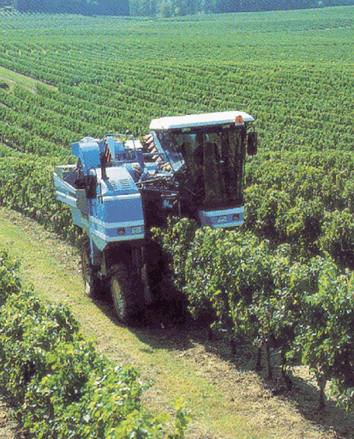Calculation of real prodution of a plot.
Page1 2 3 4
Counting from the official numbers(in red):
Tab. 5 |
Liters per year (wine)* |
Capacity of bottles |
Number of bottles |
| 27,000,000 (1) |
0.720l |
37,500,000 (4) |
| 27,000,000 (1) |
0.750l |
36,000,000 (5) |
Bottles produced ** |
Capacity of bottles |
Liters |
| 30,000,000 |
0.720l |
21,600,000 (2) |
| 30,000,000 |
0.750l |
22,500,000 (3) |
data: (*) agraria.com, (**) gambero rosso, Daniele Cernilli, www.terradaily.com (declaration of Mr Giovanni Ricasoli)
If the number of annual litres producted is correct, then the bottles produced (4-5) are not those declared (1). If the number of 30,000,000 bottles produced is correct, then the number of litres of Chianti Classico (2-3), is below what is declared. In both cases it seems that “someone” is too smart. Consistent with bottles capacity and official published data: 30,000,000 0,720l bottles, correspond to 21,600,000 litres of wine in Total. If the bottle capacity is 0.750l, then the litres are 22,500,000. The truth is that an average production of 27,000,000 liters (28,160,000 in 2007, source Chianti Classico consortium), should give rise to a number between 36,000,000 (bottles of 0750) and 37,500,000 (bottles 0.720l) a year. The fact is that: between the official number of litres and bottles produced, there is a difference of 6,000,000-7,500,000 units. Well, I just think that possibilities are just two: or there about 7,000,000 bottles, or chianti classico is actually less than what is actually sold. Uhm.. I will surely discard this last chance!!!;)
It’s not over: I’m going to suppose that 100 kg of grapes give 70 kilograms of wine as seems quite reasonable as required by the specification.
With modern presses we can get more juice, that’s a fact. 281,600Hl (official data from consortium 2007)= 28,160,000Kg. Dividing this number by productive hectares, 7100 = 4000 kg per hectare. 4000 * 30%= 1200. The yield per hectare is equal to 5,200Kg/ha and this is reasonable… for a 35 years old vineyard!!! Then… if bottles are 30,000,000, litres 22,500,000 / 7100 = 3160 * 30% = 948. 948 +3160 = 4108 kg ha. Laugh because that’s even worst! That’s a quantity produced by a 50 year old vineyard, not quantities produced by one of 4-25 years! In fact, the specification changed because young vineyards are able to produce even 140000 kg of grapes per hectare! If the declared quantity are so low… why to change maximum production limit in lower?
To confirm the assumptions above, I checked the data:"grape yield plant in Tuscan Sangiovese". Google gave me back the wikipedia page - and I start counting:
Plants per ha |
Kg grape / Plant |
Total Kg grape / ha |
Solid discharge 30% |
Kg wine/ha |
Bottle capacity |
Total Bottles / ha |
Bottles / hectare x total number of hectares of chianti officially declared (7100) |
Total of litres of wine it should be really produced |
Difference of Wine |
| 3,500 |
3 |
10,500 |
3,150 |
7,350 |
0.72 |
10208 |
72,479,167 |
52,185,000 |
|
| 3,500 |
3 |
10,500 |
3,150 |
7,350 |
0.75 |
9,800 |
69,580,000 |
52,185,000 |
|
| 4,500 |
3 |
13,500 |
4,050 |
9,450 |
0.72 |
13,125 |
93,187,500 |
67,095,000 |
+12,000,000 |
| 4,500 |
3 |
13,500 |
4,050 |
9,450 |
0.75 |
12,600 |
89,460,000 |
67,095,000 |
+12,000,000 |
| 5,500 |
3 |
16,500 |
4,950 |
11,550 |
0.72 |
16,042 |
113,895,833 |
82,005,000 |
+32,000,000 |
| 5,500 |
3 |
16,500 |
4,950 |
11,550 |
0.75 |
15,400 |
109,340,000 |
82,005,000 |
+32,000,000 |
| 6,500 |
3 |
17,875
|
5,362.5 |
12,512.50 |
0.72 |
17,378 |
134,604,167 |
96,915,000 |
+44,000,000 |
| 6,500 |
3 |
17,875
|
5,362.5 |
12,512.50 |
0.75 |
16,683 |
129,220,000 |
96,915,000 |
+44,000,000 |
 |
With a harvest machine you can loose from 8 till 16% of product. The 'harvest-machine' works in modern rows with wood-anchor for grapes |
And here is the result. Now it is clearer the effective quantity produced per hectare. In fact, these data was confirmed to me verbally.
It's even clearlier, why the limit of chianti classico has been lowered;). To be more prudent (otherwise the risk is that I want to demostrate something untrue and that would be not serious and even not fair!), so changing 3kg/plant with a 2.75Kg/plant (average weight of a bunch of Tuscan sangiovese for the number of bunches). The result is always anyway out of "D.o.c." and "d.o.c.g." and staff fconsortium appropriately 'bypassed'. Well you can see this in the way you want. The fact is that harvest is one, not 2 or 3 each plot. if it's make with the hearvest machine, than it's absolutely impossible even under false declaration to separate grapes.
Than you can easy understand than from each plot the wine is the same, a part is marked as official, a part not but the wine, the juice and all the rest is the same. Thats a swindle;) well to say who really does it's not easy but that's a clear proove about it. That's why I said that you taste wine first looking for the plots, the plants and tasting the grapes;)
Why spend billions of lire and euro to cut plants they were making a very, very high quality and almost the same quantity?
Well there is a reason if you want to change malvasia vineyeard into sangiovese vineyeards but there is no reason for sangiovese over sangiovese!
I cannot give myself another answer than someone here is playing with data in a stupid way, he plays with public money and plays more with wine!
I cannot explain myself in another way. Isn't it?
Page1 2 3 4
|





